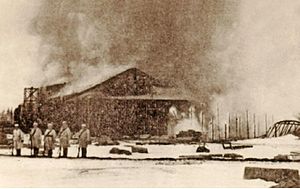Battle of Rautu (1918)
| Battle of Rautu | |||||||
|---|---|---|---|---|---|---|---|
| Part of the Finnish Civil War | |||||||
 Rautu railway station on fire |
|||||||
|
|||||||
| Belligerents | |||||||
|
|
|
||||||
| Commanders and leaders | |||||||
|
Aarne Sihvo Ernst Löfström Lennart Oesch |
M. V. Prigorovski † Oskar Rantala Arvid Leinonen Heikki Kaljunen |
||||||
| Strength | |||||||
| 2,000 | 2.700 Russians 850 Finnish Reds |
||||||
| Casualties and losses | |||||||
| 270 killed | 860–1,200 killed in action or executed | ||||||
Battle of Rautu was a 1918 Finnish Civil War battle, fought in Rautu, Finland (now Sosnovo, Leningrad Oblast, Russia) from 21 February to 5 April, 1918 between the Finnish Whites against the Finnish Reds and the Russian Bolsheviks.
The battle was fought by the Rautu railway station, taken by the Reds in late February and soon sieged by the Whites. After weeks of trench warfare, the Whites launched their decisive attack and finally smashed the Red defense on 5 April. The last two days of the Rautu battle were the one of the most fierce of all the Finnish Civil War battles. The battle is known of the massacre in the "Death Valley", where more than 400 fleeing Reds were killed by machine gun fire.
Unlike any other Finnish Civil War battle, the number of Russian Bolshevik troops was remarkable. The Russian interest is explained by Rautu's location only 60 kilometers north of Saint Petersburg. The Bolsheviks were concerned that the Finnish Whites and their ally Germany would launch an attack against the city along the Rautu railway. The Whites in turn, were protecting their front on the western side of the Karelian Isthmus.
As the Reds took the Rautu station, it was held by only less than one hundred paramilitary White Guard members, led by the engineer Kyösti Kehvola. In few days, they were reinforced by a unit of 300 men and in early March the Rautu station was sieged by 500 Whites. They were now commanded by the Jäger captain Evert Ekman and since 8 March, as the Karelian Army arrived, by the rittmeister Georg Elfvengren. Before the final battle, the Whites were reinforced with a Jäger battalion commanded by the major Lennart Oesch.
...
Wikipedia
